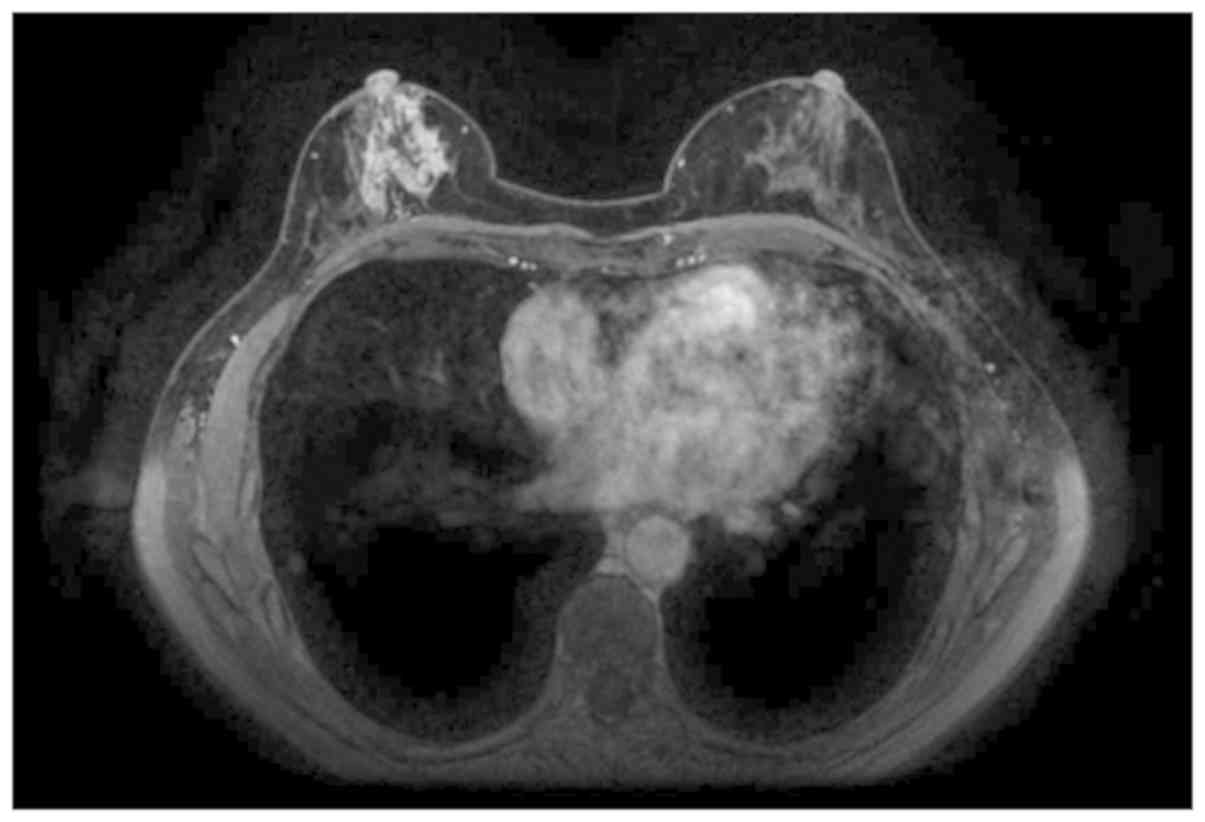|
1
|
Lee JW, Han W, Ko E, Cho J, Kim EK, Jung
SY, Cho N, Moon WK, Park IA and Noh DY: Sonographic lesion size of
ductal carcinoma in situ as a preoperative predictor for the
presence of an invasive focus. J Surg Oncol. 98:15–20.
2008.PubMed/NCBI View Article : Google Scholar
|
|
2
|
Brennan ME, Turner RM, Ciatto S,
Marinovich ML, French JR, Macaskill P and Houssami N: Ductal
Carcinoma in situ at core-needle biopsy: Meta-analysis of
underestimation and predictors of invasive breast cancer.
Radiology. 260:119–128. 2011.PubMed/NCBI View Article : Google Scholar
|
|
3
|
Wahedna Y, Evans AJ, Pinder SE, Ellis IO,
Blamey RW and Geraghty JG: Mammographic size of ductal carcinoma in
situ does not predict the presence of an invasive focus. Eur J
Cancer. 37:459–462. 2001.PubMed/NCBI View Article : Google Scholar
|
|
4
|
Darling ML, Smith DN, Lester SC, Kaelin C,
Selland DL, Denison CM, DiPiro PJ, Rose DI, Rhei E and Meyer JE:
Atypical ductal hyperplasia and ductal carcinoma in situ as
revealed by large-core needle breast biopsy: Results of surgical
excision. AJR Am J Roentgenol. 175:1341–1346. 2000.PubMed/NCBI View Article : Google Scholar
|
|
5
|
Sato Y, Kinoshita T, Suzuki J, Jimbo K,
Asaga S, Hojo T, Yoshida M and Tsuda H: Preoperatively diagnosed
ductal carcinoma in situ: Risk prediction of invasion and effects
on axillary management. Breast Cancer. 23:761–770. 2016.PubMed/NCBI View Article : Google Scholar
|
|
6
|
Kanda Y: Investigation of the freely
available easy-to-use software ‘EZR’ for medical statistics. Bone
Marrow Transplant. 48:452–458. 2013.PubMed/NCBI View Article : Google Scholar
|
|
7
|
Jackman RJ, Burbank F, Parker SH, Evans WP
III, Lechner MC, Richardson TR, Smid AA, Borofsky HB, Lee CH,
Goldstein HM, et al: Stereotactic breast biopsy of nonpalpable
lesions: Determinants of ductal carcinoma in situ underestimation
rates. Radiology. 218:497–502. 2001.PubMed/NCBI View Article : Google Scholar
|
|
8
|
King TA, Farr GH, Cederbom GJ, Smetherman
DH, Bolton JS, Stolier AJ and Fuhrman GM: A mass on breast imaging
predicts coexisting invasive carcinoma in patients with a core
biopsy diagnosis of ductal carcinoma in situ. Am Surg. 67:907–912.
2001.PubMed/NCBI
|
|
9
|
Hoorntje LE, Schipper ME, Peeters PH,
Bellot F, Storm RK and Borel Rinkes IH: The finding of invasive
cancer after a preoperative diagnosis of ductal carcinoma-in situ:
Causes of ductal carcinoma-in situ underestimates with stereotactic
14-gauge needle biopsy. Ann Surg Oncol. 10:748–753. 2003.PubMed/NCBI View Article : Google Scholar
|
|
10
|
Cho N, Moon WK, Cha JH, Kim SM, Kim SJ,
Lee SH, Chung HK, Cho KS, Park IA and Noh DY: Sonographically
guided core biopsy of the breast: Comparison of 14-gauge automated
gun and 11-gauge directional vacuum-assisted biopsy methods. Korean
J Radiol. 6:102–109. 2005.PubMed/NCBI View Article : Google Scholar
|
|
11
|
Yen TW, Hunt KK, Ross MI, Mirza NQ,
Babiera GV, Meric-Bernstam F, Singletary SE, Symmans WF, Giordano
SH, Feig BW, et al: Predictors of invasive breast cancer in
patients with an initial diagnosis of ductal carcinoma in situ: A
guide to selective use of sentinel lymph node biopsy in management
of ductal carcinoma in situ. J Am Coll Surg. 200:516–526.
2005.PubMed/NCBI View Article : Google Scholar
|
|
12
|
Cox D, Bradley S and England D: The
significance of mammotome core biopsy specimens without
radiographically identifiable microcalcification and their
influence on surgical management-a retrospective review with
histological correlation. Breast. 15:210–218. 2006.PubMed/NCBI View Article : Google Scholar
|
|
13
|
Dillon MF, McDermott EW, Quinn CM,
O'Doherty A, O'Higgins N and Hill AD: Predictors of invasive
disease in breast cancer when core biopsy demonstrates DCIS only. J
Surg Oncol. 93:559–563. 2006.PubMed/NCBI View Article : Google Scholar
|
|
14
|
Rutstein LA, Johnson RR, Poller WR, Dabbs
D, Groblewski J, Rakitt T, Tsung A, Kirchner T, Sumkin J, Keenan D,
et al: Predictors of residual invasive disease after core needle
biopsy diagnosis of ductal carcinoma in situ. Breast J. 13:251–257.
2007.PubMed/NCBI View Article : Google Scholar
|
|
15
|
Trentin C, Dominelli V, Maisonneuve P,
Menna S, Bazolli B, Luini A and Cassano E: Predictors of invasive
breast cancer and lymph node involvement in ductal carcinoma in
situ initially diagnosed by vacuum-assisted breast biopsy:
Experience of 733 cases. Breast. 21:635–640. 2012.PubMed/NCBI View Article : Google Scholar
|
|
16
|
Mustafa RE, DeStefano LM, Bahng J,
Yoon-Flannery K, Fisher CS, Zhang PJ, Tchou J, Czerniecki BJ and De
La Cruz LM: Evaluating the risk of upstaging HER2-positive DCIS to
invasive breast cancer. Ann Surg Oncol. 24:2999–3003.
2017.PubMed/NCBI View Article : Google Scholar
|
|
17
|
Di Cesare P, Pavesi L, Villani L,
Battaglia A, Da Prada GA, Riccardi A and Frascaroli M: The
relationships between HER2 overexpression and DCIS characteristics.
Breast J. 23:307–314. 2017.PubMed/NCBI View Article : Google Scholar
|
|
18
|
Monabati A, Sokouti AR, Noori SN, Safaei
A, Talei AR, Omidvari S and Azarpira N: Large palpable ductal
carcinoma in situ is Her-2 positive with high nuclear grade. Int J
Clin Exp Pathol. 8:3963–3970. 2015.PubMed/NCBI
|















